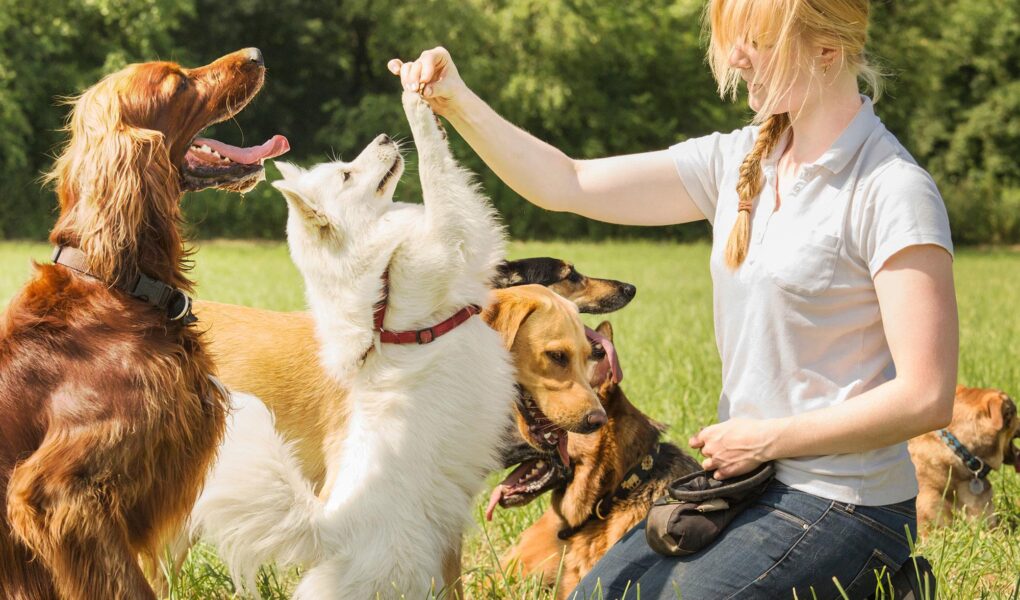Unleashing Your Potential: The Journey to Becoming a Dog Trainer
In a world where the wag of a tail can brighten even the gloomiest of days, the bond between humans and their canine companions continues to deepen. As the ranks of dog owners swell, so too does the demand for skilled trainers who possess the knowledge, patience, and passion to guide both dogs and their families toward harmonious living. But what does it take to embark on this rewarding path? Becoming a dog trainer is more than simply teaching an array of commands; it is about understanding the intricate language of dogs, recognizing their behaviors, and fostering connections that last a lifetime. Whether you envision yourself working in bustling training facilities, collaborating with families in their homes, or even developing your own niche, the journey to becoming a dog trainer is a unique blend of education, experience, and empathy. Join us as we explore the essential steps, challenges, and joys that await you in this fulfilling vocation, where every bark and wag is a testament to the bond you help to strengthen.
Table of Contents
- Exploring the Foundations of Dog Training Techniques
- Building Effective Communication Skills with Canines
- Navigating Certification and Professional Development Paths
- Creating a Successful Business Model for Aspiring Trainers
- Q&A
- In Retrospect
Exploring the Foundations of Dog Training Techniques
Understanding the core principles behind dog training techniques is essential for any aspiring trainer. At the heart of effective training lies the relationship between the trainer and the dog, built on trust, respect, and communication. It’s crucial to recognize that each dog is unique, responding to different stimuli and learning styles. Here are some fundamental concepts that shape successful training practices:
- Positive Reinforcement: Rewarding desirable behaviors to encourage repetition.
- Consistency: Maintaining a uniform approach in commands and rules to prevent confusion.
- Timing: Delivering rewards or corrections at the right moment to effectively influence behavior.
In addition to these concepts, various training methods can be employed to suit individual needs. While some trainers may opt for clicker training or obedience school foundations, others might lean towards behavioral modification techniques. It is vital to adapt the training style to the dog’s personality and state of mind. Below is a comparative table highlighting different training methodologies:
| Training Method | Description | Best For |
|---|---|---|
| Clicker Training | Using a click sound to mark desired behavior. | Positive reinforcement learners |
| Leash Training | Teaching proper walking behavior on a leash. | Active dogs or leash pullers |
| Behavior Modification | Changing unwanted behaviors through various techniques. | Dogs with specific issues (aggression, fear) |
Building Effective Communication Skills with Canines
To forge a strong bond with canines and become an effective communicator, it is essential to understand not just verbal cues, but also non-verbal signals. Dogs communicate predominantly through body language, and developing the ability to interpret these signals is crucial. Key aspects to focus on include:
- Eye Contact: Dogs express attentiveness through their gaze, and avoiding eye contact can signify discomfort or submission.
- Body Posture: A relaxed dog often has an open stance, while a rigid posture may indicate tension or aggression.
- Tail Position: The position and movement of a dog’s tail can convey excitement, submission, or anxiety, helping trainers assess their state of mind.
Additionally, incorporating clear verbal commands while pairing them with consistent gestures fosters better understanding. When teaching commands, it can be beneficial to track progress in a structured way. Consider using a simple table format to document training sessions:
| Command | Dog’s Response | Date |
|---|---|---|
| Sit | Responded promptly | 2023-10-15 |
| Stay | Prolonged duration | 2023-10-17 |
| Come | Delayed response | 2023-10-19 |
This systematic approach not only enhances the learning experience but also enables you to celebrate small victories along the way, reinforcing a positive environment for both the trainer and the canine companion.
Navigating Certification and Professional Development Paths
Embarking on a journey to become a dog trainer requires a blend of passion, knowledge, and practical skills. Aspiring trainers often pursue various certifications to boost their credibility and expertise in the field. The following are some popular options:
- Certified Professional Dog Trainer (CPDT) - Recognized for its rigorous examination and adherence to ethical standards.
- Animal Behavior College Certification – Combines hands-on training with online coursework.
- International Association of Animal Behavior Consultants (IAABC) - Focuses on behavior modification techniques.
In addition to certifications, ongoing professional development is crucial to staying updated with the latest training methods and canine behavior. This can include attending workshops, seminars, or online courses that dive deeper into specialized areas such as agility training or behavioral issues. Moreover, gaining experience through internships or volunteer work at local shelters can also enhance skills and build practical knowledge. Consider the following avenues for growth:
- Mentorship Programs – Learning directly from seasoned trainers.
- Webinars and Online Classes – Flexible learning to fit your schedule.
- Professional Conferences – Networking and insight into industry trends.
Creating a Successful Business Model for Aspiring Trainers
To build a successful business model as an aspiring dog trainer, it’s essential to identify your target audience and niche. Consider what types of dog training you wish to specialize in, whether that’s obedience training, agility, or behavior modification. Once you define your niche, focus on developing a unique selling proposition (USP) that sets you apart from competitors. This could be your training methodology, your personal experiences, or even your credentials. Engage with potential clients through social media and local community events to establish a clientele base while promoting your expertise.
Additionally, having a well-structured pricing strategy is key to sustaining your business. You might opt for various models such as:
- Hourly sessions – charging clients per session
- Package deals – offering discounts for multiple sessions purchased
- Group classes – providing training for multiple dogs in a single session at a reduced rate
Moreover, consider holding workshops or webinars to widen your reach and maximize your income potential. By offering valuable content, not only do you enhance your reputation as an expert, but you also build trust with your audience, ultimately leading to more clients and referrals.
Q&A
Q&A: Becoming a Dog Trainer
Q1: What inspired you to become a dog trainer?
A1: My journey began with an unquenchable love for dogs. I volunteered at a local shelter, where I discovered the immense joy in helping dogs find their forever homes. Observing how effective training transformed their behaviors ignited my passion. It became clear that I wanted to dedicate my life to enhancing the bond between dogs and their humans.
Q2: What qualifications or certifications do I need to become a dog trainer?
A2: While formal education is not mandatory, certifications from reputable organizations like the Association of Professional Dog Trainers (APDT) or the Certification Council for Professional Dog Trainers (CCPDT) can lend credibility to your practice. Additionally, hands-on experience through internships or shadowing established trainers is invaluable. This practical exposure helps in understanding various training techniques and dog behaviors.
Q3: Can anyone become a dog trainer, or do you need to have prior experience with animals?
A3: While a background with animals is beneficial, anyone with a genuine passion for dogs can become a trainer. The key is to harness that passion into learning. Many successful trainers started with little to no experience but dedicated time to studying canine behavior, psychology, and training methods.
Q4: What are some common training methods, and how do I choose the right one?
A4: There are various training methods, including positive reinforcement, clicker training, and the dominance theory approach. Positive reinforcement, which rewards desired behaviors, is generally the most recommended as it promotes a trusting relationship between the dog and trainer. To choose the right method, it’s crucial to consider the dog’s individual personality and the specific behaviors you’re aiming to address.
Q5: What challenges might I face as a dog trainer?
A5: Every trainer encounters challenges, from the unpredictability of canine behavior to managing a diverse clientele. Patience is essential, as progress can be slow. Additionally, some owners may have preconceived notions about training that can complicate the process. The ability to communicate effectively and adapt to various situations is crucial.
Q6: How can I start my own dog training business?
A6: Starting your own business involves careful planning. First, gain experience and build your reputation through classes and workshops. Once confident in your skills, create a business plan that outlines your services, pricing, and marketing strategy. Networking within the pet community and utilizing social media can help attract clients. Remember, a solid understanding of business fundamentals will support your training expertise.
Q7: What is the most rewarding aspect of being a dog trainer?
A7: The most rewarding part is witnessing the transformation in both dogs and their owners. Helping a shy dog overcome fears or teaching an owner to communicate effectively with their pet creates lasting bonds. Each successful training milestone reinforces the profound impact trainers can have on the lives of both dogs and their families.
Q8: How can I stay updated on the latest training techniques?
A8: The field of dog training is ever-evolving. To stay current, engage in continuous education by attending workshops, webinars, and conferences. Joining professional organizations can also provide access to resources and a network of fellow trainers. Following canine behaviorists and trainers on social media, and reading relevant literature can also keep your knowledge fresh and well-rounded.
Feel free to ask more questions or dive deeper into specific areas related to becoming a dog trainer!
In Retrospect
As we conclude our journey through the rewarding world of dog training, it’s clear that the path to becoming a skilled trainer is paved with patience, empathy, and a commitment to lifelong learning. Just like our canine companions, each aspiring trainer has a unique story, filled with challenges and triumphs. Embracing this journey not only strengthens the bond between humans and dogs but also enriches our lives in unexpected ways.
Whether you choose to turn a passion into a profession or simply wish to elevate your skills for the joy of training your own pup, the key lies in understanding that every dog’s journey is different, and so is yours. So take that first step, invest in your education, and remember—every wag of the tail and gleam in the eye is a testament to the connection you foster. With dedication and love, you’re not just training dogs; you’re changing lives, one bark at a time. Happy training!



